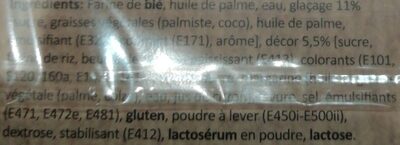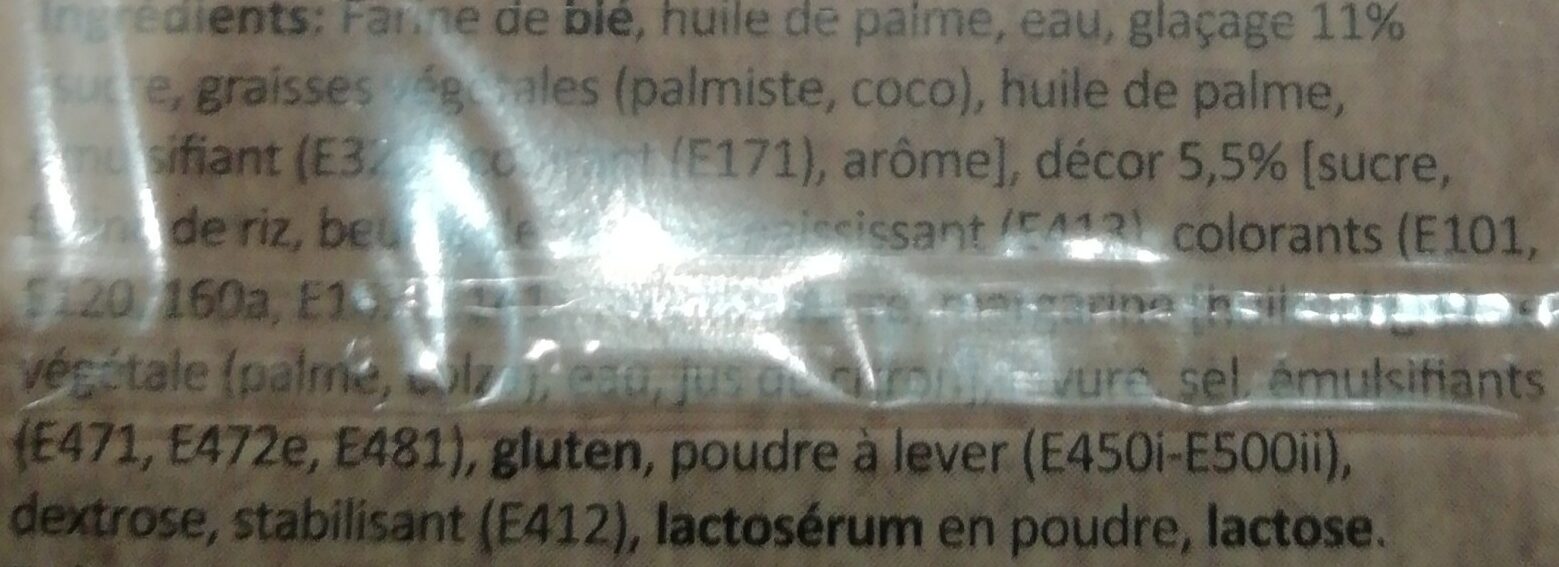Help us make food transparency the norm!
As a non-profit organization, we depend on your donations to continue informing consumers around the world about what they eat.
The food revolution starts with you!
Mini Donuts Coating blanc x 4 - Carrefour - 60 g (4 x 15 g)
Mini Donuts Coating blanc x 4 - Carrefour - 60 g (4 x 15 g)
Important note: this product is no longer sold. The data is kept for reference only. This product does not appear in regular searches and is not taken into account for statistics.
This product page is not complete. You can help to complete it by editing it and adding more data from the photos we have, or by taking more photos using the app for Android or iPhone/iPad. Thank you!
×
Some of the data for this product has been provided directly by the manufacturer Carrefour.
Barcode: 3523680307803 (EAN / EAN-13)
Quantity: 60 g (4 x 15 g)
Brands: Carrefour
Categories: Snacks, Sweet snacks, Biscuits and cakes, Cakes, Doughnuts, Biscuit with chocolate covering
Stores: carrefour.fr, Carrefour
Countries where sold: France
Matching with your preferences
Health
Ingredients
-
47 ingredients
: Farine de BLE, huile de palme, eau, glaçage 11% [sucre, huile et graisses végétales (palmiste, palme, coco), émulsifiant (E322), colorant (E171), arôme], décor 5,5% [sucre, farine de riz, beurre de cacao, épaississant (E413), colorants (E101, E120, E1601a, E163, E141), arôme], sucre, margarine [huile et graisse végétale (palme, colza), eau, jus de citron], levure, sel, émulsifiants (E471, E472e, E481), GLUTEN, poudre à lever (E450i, E500ii), dextrose, stabilisant (E412), LACTOSERUM en poudre, LACTOSE.Allergens: Gluten, MilkTraces: Nuts
Food processing
-
Ultra processed foods
Elements that indicate the product is in the 4 - Ultra processed food and drink products group:
- Additive: E101 - Riboflavin
- Additive: E120 - Cochineal
- Additive: E141 - Copper complexes of chlorophylls and chlorophyllins
- Additive: E163 - Anthocyanins
- Additive: E171 - Titanium dioxide
- Additive: E322 - Lecithins
- Additive: E412 - Guar gum
- Additive: E413 - Tragacanth
- Additive: E450 - Diphosphates
- Additive: E471 - Mono- and diglycerides of fatty acids
- Additive: E472e - Mono- and diacetyltartaric acid esters of mono- and diglycerides of fatty acids
- Additive: E481 - Sodium stearoyl-2-lactylate
- Ingredient: Colour
- Ingredient: Dextrose
- Ingredient: Emulsifier
- Ingredient: Flavouring
- Ingredient: Glucose
- Ingredient: Gluten
- Ingredient: Lactose
- Ingredient: Thickener
- Ingredient: Whey
Food products are classified into 4 groups according to their degree of processing:
- Unprocessed or minimally processed foods
- Processed culinary ingredients
- Processed foods
- Ultra processed foods
The determination of the group is based on the category of the product and on the ingredients it contains.
Additives
-
E101 - Riboflavin
Riboflavin: Riboflavin, also known as vitamin B2, is a vitamin found in food and used as a dietary supplement. Food sources include eggs, green vegetables, milk and other dairy product, meat, mushrooms, and almonds. Some countries require its addition to grains. As a supplement it is used to prevent and treat riboflavin deficiency and prevent migraines. It may be given by mouth or injection.It is nearly always well tolerated. Normal doses are safe during pregnancy. Riboflavin is in the vitamin B group. It is required by the body for cellular respiration.Riboflavin was discovered in 1920, isolated in 1933, and first made in 1935. It is on the World Health Organization's List of Essential Medicines, the most effective and safe medicines needed in a health system. Riboflavin is available as a generic medication and over the counter. In the United States a month of supplements costs less than 25 USD.Source: Wikipedia
-
E120 - Cochineal
Carminic acid: Carminic acid -C22H20O13- is a red glucosidal hydroxyanthrapurin that occurs naturally in some scale insects, such as the cochineal, Armenian cochineal, and Polish cochineal. The insects produce the acid as a deterrent to predators. An aluminum salt of carminic acid is the coloring agent in carmine. Synonyms are C.I. 75470 and C.I. Natural Red 4. The chemical structure of carminic acid consists of a core anthraquinone structure linked to a glucose sugar unit. Carminic acid was first synthesized in the laboratory by organic chemists in 1991.Source: Wikipedia
-
E163 - Anthocyanins
Anthocyanin: Anthocyanins -also anthocyans; from Greek: ἄνθος -anthos- "flower" and κυάνεος/κυανοῦς kyaneos/kyanous "dark blue"- are water-soluble vacuolar pigments that, depending on their pH, may appear red, purple, or blue. Food plants rich in anthocyanins include the blueberry, raspberry, black rice, and black soybean, among many others that are red, blue, purple, or black. Some of the colors of autumn leaves are derived from anthocyanins.Anthocyanins belong to a parent class of molecules called flavonoids synthesized via the phenylpropanoid pathway. They occur in all tissues of higher plants, including leaves, stems, roots, flowers, and fruits. Anthocyanins are derived from anthocyanidins by adding sugars. They are odorless and moderately astringent. Although approved to color foods and beverages in the European Union, anthocyanins are not approved for use as a food additive because they have not been verified as safe when used as food or supplement ingredients. There is no conclusive evidence anthocyanins have any effect on human biology or diseases.Source: Wikipedia
-
E171 - Titanium dioxide
Titanium dioxide: Titanium dioxide, also known as titaniumIV oxide or titania, is the naturally occurring oxide of titanium, chemical formula TiO2. When used as a pigment, it is called titanium white, Pigment White 6 -PW6-, or CI 77891. Generally, it is sourced from ilmenite, rutile and anatase. It has a wide range of applications, including paint, sunscreen and food coloring. When used as a food coloring, it has E number E171. World production in 2014 exceeded 9 million metric tons. It has been estimated that titanium dioxide is used in two-thirds of all pigments, and the oxide has been valued at $13.2 billion.Source: Wikipedia
-
E322 - Lecithins
Lecithins are natural compounds commonly used in the food industry as emulsifiers and stabilizers.
Extracted from sources like soybeans and eggs, lecithins consist of phospholipids that enhance the mixing of oil and water, ensuring smooth textures in various products like chocolates, dressings, and baked goods.
They do not present any known health risks.
-
E412 - Guar gum
Guar gum (E412) is a natural food additive derived from guar beans.
This white, odorless powder is valued for its remarkable thickening and stabilizing properties, making it a common ingredient in various food products, including sauces, dressings, and ice creams.
When used in moderation, guar gum is considered safe for consumption, with no known adverse health effects.
-
E413 - Tragacanth
Tragacanth: Tragacanth is a natural gum obtained from the dried sap of several species of Middle Eastern legumes of the genus Astragalus, including A. adscendens, A. gummifer, A. brachycalyx, and A. tragacantha. Some of these species are known collectively under the common names "goat's thorn" and "locoweed". The gum is sometimes called Shiraz gum, shiraz, gum elect or gum dragon. The name derives from the Greek words tragos -meaning "goat"- and akantha -"thorn"-. Iran is the biggest producer of this gum. Gum tragacanth is a viscous, odorless, tasteless, water-soluble mixture of polysaccharides obtained from sap that is drained from the root of the plant and dried. The gum seeps from the plant in twisted ribbons or flakes that can be powdered. It absorbs water to become a gel, which can be stirred into a paste. The major fractions are known as tragacanthin, highly water soluble as a mucilaginous colloid, and the chemically related bassorin, which is far less soluble but swells in water to form a gel. The gum is used in vegetable-tanned leatherworking as an edge slicking and burnishing compound, and is occasionally used as a stiffener in textiles. The gum has been used historically as a herbal remedy for such conditions as cough and diarrhea. As a mucilage or paste, it has been used as a topical treatment for burns. It is used in pharmaceuticals and foods as an emulsifier, thickener, stabilizer, and texturant additive -E number E413-. It is the traditional binder used in the making of artists' pastels, as it does not adhere to itself the same way other gums -such as gum arabic- do when dry. Gum tragacanth is also used to make a paste used in floral sugarcraft to create lifelike flowers on wires used as decorations for cakes, which air-dries brittle and can take colorings. It enables users to get a very fine, delicate finish to their work. It has traditionally been used as an adhesive in the cigar-rolling process used to secure the cap or "flag" leaf to the finished cigar body.Gum tragacanth is less common in products than other, usually cheaper, gums, such as gum arabic or guar gum. Different gums tend to be interchangeable across many uses, and production of tragacanth is far outpaced by these for reasons of economy, trade, agriculture and history, while tragacanth is mostly produced in traditional locations. However, gums are used in varied circumstances and there are many situations where tragacanth is considered superior. Common substitutions are methyl cellulose, sometimes marketed as "substitute gum tragacanth" in the food industry, and gum karaya. Gum karaya, also called "Indian tragacanth" or simply "tragacanth", might be fully or partially substituted for what appears to be genuine tragacanth. Gum tragacanth is also used in incense-making as a binder to hold all the powdered herbs together. Its water solubility is ideal for ease of working and an even spread, and it is one of the stronger gums for holding particles in suspension. Only half as much is needed, compared to gum arabic or something similar.In Saudi Arabia, a mixture of hydrated Tragacanth and ground dried Ziziphus spina-christi is used as a natural hair shampoo that is believed to promote hair growth.Source: Wikipedia
-
E450 - Diphosphates
Diphosphates (E450) are food additives often utilized to modify the texture of products, acting as leavening agents in baking and preventing the coagulation of canned food.
These salts can stabilize whipped cream and are also found in powdered products to maintain their flow properties. They are commonly present in baked goods, processed meats, and soft drinks.
Derived from phosphoric acid, they're part of our daily phosphate intake, which often surpasses recommended levels due to the prevalence of phosphates in processed foods and drinks.
Excessive phosphate consumption is linked to health issues, such as impaired kidney function and weakened bone health. Though diphosphates are generally regarded as safe when consumed within established acceptable daily intakes, it's imperative to monitor overall phosphate consumption to maintain optimal health.
-
E471 - Mono- and diglycerides of fatty acids
Mono- and diglycerides of fatty acids (E471), are food additives commonly used as emulsifiers in various processed foods.
These compounds consist of glycerol molecules linked to one or two fatty acid chains, which help stabilize and blend water and oil-based ingredients. E471 enhances the texture and shelf life of products like margarine, baked goods, and ice cream, ensuring a smooth and consistent texture.
It is generally considered safe for consumption within established regulatory limits.
-
E481 - Sodium stearoyl-2-lactylate
Sodium stearoyl lactylate: Sodium stearoyl-2-lactylate -sodium stearoyl lactylate or SSL- is a versatile, FDA approved food additive used to improve the mix tolerance and volume of processed foods. It is one type of a commercially available lactylate. SSL is non-toxic, biodegradable, and typically manufactured using biorenewable feedstocks. Because SSL is a safe and highly effective food additive, it is used in a wide variety of products ranging from baked goods and desserts to pet foods.As described by the Food Chemicals Codex 7th edition, SSL is a cream-colored powder or brittle solid. SSL is currently manufactured by the esterification of stearic acid with lactic acid and partially neutralized with either food-grade soda ash -sodium carbonate- or caustic soda -concentrated sodium hydroxide-. Commercial grade SSL is a mixture of sodium salts of stearoyl lactylic acids and minor proportions of other sodium salts of related acids. The HLB for SSL is 10-12. SSL is slightly hygroscopic, soluble in ethanol and in hot oil or fat, and dispersible in warm water. These properties are the reason that SSL is an excellent emulsifier for fat-in-water emulsions and can also function as a humectant.Source: Wikipedia
-
E500 - Sodium carbonates
Sodium carbonates (E500) are compounds commonly used in food preparation as leavening agents, helping baked goods rise by releasing carbon dioxide when they interact with acids.
Often found in baking soda, they regulate the pH of food, preventing it from becoming too acidic or too alkaline. In the culinary world, sodium carbonates can also enhance the texture and structure of foods, such as noodles, by modifying the gluten network.
Generally recognized as safe, sodium carbonates are non-toxic when consumed in typical amounts found in food.
-
E500ii - Sodium hydrogen carbonate
Sodium hydrogen carbonate, also known as E500ii, is a food additive commonly used as a leavening agent.
When added to recipes, it releases carbon dioxide gas upon exposure to heat or acids, causing dough to rise and resulting in a light, fluffy texture in baked goods.
It is generally recognized as safe (GRAS) by regulatory authorities when used in appropriate quantities and poses no significant health risks when consumed in typical food applications.
Ingredients analysis
-
Palm oil
Ingredients that contain palm oil: Palm oil, Palm kernel oil and fat, Palm fat, Palm oil and fat
-
Non-vegan
Non-vegan ingredients: E120, Whey powder, LactoseSome ingredients could not be recognized.
We need your help!
You can help us recognize more ingredients and better analyze the list of ingredients for this product and others:
- Edit this product page to correct spelling mistakes in the ingredients list, and/or to remove ingredients in other languages and sentences that are not related to the ingredients.
- Add new entries, synonyms or translations to our multilingual lists of ingredients, ingredient processing methods, and labels.
If you would like to help, join the #ingredients channel on our Slack discussion space and/or learn about ingredients analysis on our wiki. Thank you!
-
Non-vegetarian
Non-vegetarian ingredients: E120Some ingredients could not be recognized.
We need your help!
You can help us recognize more ingredients and better analyze the list of ingredients for this product and others:
- Edit this product page to correct spelling mistakes in the ingredients list, and/or to remove ingredients in other languages and sentences that are not related to the ingredients.
- Add new entries, synonyms or translations to our multilingual lists of ingredients, ingredient processing methods, and labels.
If you would like to help, join the #ingredients channel on our Slack discussion space and/or learn about ingredients analysis on our wiki. Thank you!
-
Details of the analysis of the ingredients
We need your help!
Some ingredients could not be recognized.
We need your help!
You can help us recognize more ingredients and better analyze the list of ingredients for this product and others:
- Edit this product page to correct spelling mistakes in the ingredients list, and/or to remove ingredients in other languages and sentences that are not related to the ingredients.
- Add new entries, synonyms or translations to our multilingual lists of ingredients, ingredient processing methods, and labels.
If you would like to help, join the #ingredients channel on our Slack discussion space and/or learn about ingredients analysis on our wiki. Thank you!
: Farine de BLE, huile de palme, eau, glaçage 11% (sucre, huile et graisses végétales de palmiste, graisses végétales de palme, graisses végétales de coco, émulsifiant (e322), colorant (e171), arôme), décor 5.5% (sucre, farine de riz, beurre de cacao, épaississant (e413), colorants (e101, e120, e1601a, e163, e141), arôme), sucre, margarine (huile et graisse végétale de palme, graisse végétale de colza, eau, jus de citron), levure, sel, émulsifiants (e471, e472e, e481), GLUTEN, poudre à lever (e450i, e500ii), dextrose, stabilisant (e412), LACTOSERUM en poudre, LACTOSE- Farine de BLE -> en:wheat-flour - vegan: yes - vegetarian: yes - percent_min: 11 - percent_max: 61.5
- huile de palme -> en:palm-oil - vegan: yes - vegetarian: yes - from_palm_oil: yes - ciqual_food_code: 16129 - percent_min: 11 - percent_max: 36.25
- eau -> en:water - vegan: yes - vegetarian: yes - ciqual_food_code: 18066 - percent_min: 11 - percent_max: 27.8333333333333
- glaçage -> en:glaze - percent_min: 11 - percent: 11 - percent_max: 11
- sucre -> en:sugar - vegan: yes - vegetarian: yes - percent_min: 1.57142857142857 - percent_max: 11
- huile et graisses végétales de palmiste -> en:palm-kernel-oil-and-fat - vegan: yes - vegetarian: yes - from_palm_oil: yes - percent_min: 0 - percent_max: 5.5
- graisses végétales de palme -> en:palm-fat - vegan: yes - vegetarian: yes - from_palm_oil: yes - percent_min: 0 - percent_max: 3.66666666666667
- graisses végétales de coco -> en:coconut-oil - vegan: yes - vegetarian: yes - from_palm_oil: no - percent_min: 0 - percent_max: 2.75
- émulsifiant -> en:emulsifier - percent_min: 0 - percent_max: 2.2
- e322 -> en:e322 - vegan: maybe - vegetarian: maybe - percent_min: 0 - percent_max: 2.2
- colorant -> en:colour - percent_min: 0 - percent_max: 1.83333333333333
- e171 -> en:e171 - vegan: yes - vegetarian: yes - percent_min: 0 - percent_max: 1.83333333333333
- arôme -> en:flavouring - vegan: maybe - vegetarian: maybe - percent_min: 0 - percent_max: 1.57142857142857
- décor -> en:coating - vegan: ignore - vegetarian: ignore - percent_min: 5.5 - percent: 5.5 - percent_max: 5.5
- sucre -> en:sugar - vegan: yes - vegetarian: yes - percent_min: 0.916666666666667 - percent_max: 5.5
- farine de riz -> en:rice-flour - vegan: yes - vegetarian: yes - ciqual_food_code: 9520 - percent_min: 0 - percent_max: 2.75
- beurre de cacao -> en:cocoa-butter - vegan: yes - vegetarian: yes - ciqual_food_code: 16030 - percent_min: 0 - percent_max: 1.83333333333333
- épaississant -> en:thickener - percent_min: 0 - percent_max: 1.375
- e413 -> en:e413 - vegan: yes - vegetarian: yes - percent_min: 0 - percent_max: 1.375
- colorants -> en:colour - percent_min: 0 - percent_max: 1.1
- e101 -> en:e101 - vegan: maybe - vegetarian: yes - percent_min: 0 - percent_max: 1.1
- e120 -> en:e120 - vegan: no - vegetarian: no - percent_min: 0 - percent_max: 0.55
- e1601a -> fr:e1601a - percent_min: 0 - percent_max: 0.366666666666667
- e163 -> en:e163 - vegan: yes - vegetarian: yes - percent_min: 0 - percent_max: 0.275
- e141 -> en:e141 - vegan: yes - vegetarian: yes - percent_min: 0 - percent_max: 0.22
- arôme -> en:flavouring - vegan: maybe - vegetarian: maybe - percent_min: 0 - percent_max: 0.916666666666667
- sucre -> en:sugar - vegan: yes - vegetarian: yes - percent_min: 0 - percent_max: 5.5
- margarine -> en:margarine - percent_min: 0 - percent_max: 5.5
- huile et graisse végétale de palme -> en:palm-oil-and-fat - vegan: yes - vegetarian: yes - from_palm_oil: yes - percent_min: 0 - percent_max: 5.5
- graisse végétale de colza -> en:colza-oil - vegan: yes - vegetarian: yes - from_palm_oil: no - ciqual_food_code: 17130 - percent_min: 0 - percent_max: 2.75
- eau -> en:water - vegan: yes - vegetarian: yes - ciqual_food_code: 18066 - percent_min: 0 - percent_max: 1.83333333333333
- jus de citron -> en:lemon-juice - vegan: yes - vegetarian: yes - ciqual_food_code: 2028 - percent_min: 0 - percent_max: 1.375
- levure -> en:yeast - vegan: yes - vegetarian: yes - percent_min: 0 - percent_max: 5.5
- sel -> en:salt - vegan: yes - vegetarian: yes - ciqual_food_code: 11058 - percent_min: 0 - percent_max: 5.5
- émulsifiants -> en:emulsifier - percent_min: 0 - percent_max: 5.5
- e471 -> en:e471 - vegan: maybe - vegetarian: maybe - from_palm_oil: maybe - percent_min: 0 - percent_max: 5.5
- e472e -> en:e472e - vegan: maybe - vegetarian: maybe - from_palm_oil: maybe - percent_min: 0 - percent_max: 2.75
- e481 -> en:e481 - vegan: maybe - vegetarian: maybe - from_palm_oil: maybe - percent_min: 0 - percent_max: 1.83333333333333
- GLUTEN -> en:gluten - vegan: yes - vegetarian: yes - percent_min: 0 - percent_max: 5.5
- poudre à lever -> en:raising-agent - percent_min: 0 - percent_max: 5.5
- e450i -> en:e450i - vegan: yes - vegetarian: yes - percent_min: 0 - percent_max: 5.5
- e500ii -> en:e500ii - vegan: yes - vegetarian: yes - percent_min: 0 - percent_max: 2.75
- dextrose -> en:dextrose - vegan: yes - vegetarian: yes - percent_min: 0 - percent_max: 5.5
- stabilisant -> en:stabiliser - percent_min: 0 - percent_max: 5.125
- e412 -> en:e412 - vegan: yes - vegetarian: yes - percent_min: 0 - percent_max: 5.125
- LACTOSERUM en poudre -> en:whey-powder - vegan: no - vegetarian: maybe - percent_min: 0 - percent_max: 4.73076923076923
- LACTOSE -> en:lactose - vegan: no - vegetarian: yes - percent_min: 0 - percent_max: 4.39285714285714
Nutrition
-
Bad nutritional quality
⚠ ️Warning: the amount of fiber is not specified, their possible positive contribution to the grade could not be taken into account.⚠ ️Warning: the amount of fruits, vegetables and nuts is not specified on the label, it was estimated from the list of ingredients: 0This product is not considered a beverage for the calculation of the Nutri-Score.
Positive points: 0
- Proteins: 2 / 5 (value: 4.8, rounded value: 4.8)
- Fiber: 0 / 5 (value: 0, rounded value: 0)
- Fruits, vegetables, nuts, and colza/walnut/olive oils: 0 / 5 (value: 0, rounded value: 0)
Negative points: 23
- Energy: 5 / 10 (value: 1870, rounded value: 1870)
- Sugars: 3 / 10 (value: 16, rounded value: 16)
- Saturated fat: 10 / 10 (value: 15, rounded value: 15)
- Sodium: 5 / 10 (value: 480, rounded value: 480)
The points for proteins are not counted because the negative points are greater or equal to 11.
Nutritional score: 23 (23 - 0)
Nutri-Score: E
-
Nutrient levels
-
Fat in high quantity (27%)
What you need to know- A high consumption of fat, especially saturated fats, can raise cholesterol, which increases the risk of heart diseases.
Recommendation: Limit the consumption of fat and saturated fat- Choose products with lower fat and saturated fat content.
-
Saturated fat in high quantity (15%)
What you need to know- A high consumption of fat, especially saturated fats, can raise cholesterol, which increases the risk of heart diseases.
Recommendation: Limit the consumption of fat and saturated fat- Choose products with lower fat and saturated fat content.
-
Sugars in high quantity (16%)
What you need to know- A high consumption of sugar can cause weight gain and tooth decay. It also augments the risk of type 2 diabetes and cardio-vascular diseases.
Recommendation: Limit the consumption of sugar and sugary drinks- Sugary drinks (such as sodas, fruit beverages, and fruit juices and nectars) should be limited as much as possible (no more than 1 glass a day).
- Choose products with lower sugar content and reduce the consumption of products with added sugars.
-
Salt in moderate quantity (1.2%)
What you need to know- A high consumption of salt (or sodium) can cause raised blood pressure, which can increase the risk of heart disease and stroke.
- Many people who have high blood pressure do not know it, as there are often no symptoms.
- Most people consume too much salt (on average 9 to 12 grams per day), around twice the recommended maximum level of intake.
Recommendation: Limit the consumption of salt and salted food- Reduce the quantity of salt used when cooking, and don't salt again at the table.
- Limit the consumption of salty snacks and choose products with lower salt content.
-
-
Nutrition facts
Nutrition facts As sold
for 100 g / 100 mlCompared to: Biscuit with chocolate covering Energy 1,870 kj
(447 kcal)-9% Fat 27 g +13% Saturated fat 15 g +15% Carbohydrates 46 g -24% Sugars 16 g -51% Fiber ? Proteins 4.8 g -25% Salt 1.2 g +130% Fruits‚ vegetables‚ nuts and rapeseed‚ walnut and olive oils (estimate from ingredients list analysis) 0 %
Environment
-
Eco-Score D - High environmental impact
⚠ ️Select a country in order to include the full impact of transportation.The Eco-Score is an experimental score that summarizes the environmental impacts of food products.→ The Eco-Score was initially developped for France and it is being extended to other European countries. The Eco-Score formula is subject to change as it is regularly improved to make it more precise and better suited to each country.Life cycle analysis
-
Average impact of products of the same category: C (Score: 52/100)
Category: Biscuit (cookie), chocolate covering
Category: Biscuit (cookie), chocolate covering
- PEF environmental score: 0.52 (the lower the score, the lower the impact)
- including impact on climate change: 6.74 kg CO2 eq/kg of product
Stage Impact Agriculture
52.4 %Processing
41.6 %Packaging
2.1 %Transportation
2.9 %Distribution
0.9 %Consumption
0.0 %
Bonuses and maluses
-
Missing origins of ingredients information
Malus: -5
⚠ ️ The origins of the ingredients of this product are not indicated.
If they are indicated on the packaging, you can modify the product sheet and add them.
If you are the manufacturer of this product, you can send us the information with our free platform for producers.
-
Ingredients that threatens species
Malus: -10
Contains palm oil
Tropical forests in Asia, Africa and Latin America are destroyed to create and expand oil palm tree plantations. The deforestation contributes to climate change, and it endangers species such as the orangutan, the pigmy elephant and the Sumatran rhino.
-
Packaging with a medium impact
Malus: -11
Shape Material Recycling Impact 1 Bag Plastic Discard High 1 Tray Cardboard Recycle Low
Eco-Score for this product
-
Impact for this product: D (Score: 26/100)
Product: Mini Donuts Coating blanc x 4 - Carrefour - 60 g (4 x 15 g)
Life cycle analysis score: 52
Sum of bonuses and maluses: -26
Final score: 26/100
-
Carbon footprint
-
Equal to driving 3.5 km in a petrol car
674 g CO² per 100g of product
The carbon emission figure comes from ADEME's Agribalyse database, for the category: Biscuit (cookie), chocolate covering (Source: ADEME Agribalyse Database)
Stage Impact Agriculture
36.3 %Processing
59.2 %Packaging
1.6 %Transportation
2.6 %Distribution
0.3 %Consumption
0.0 %
Packaging
-
Packaging with a medium impact
-
Packaging parts
1 x Tray (Cardboard)
1 x Bag (Plastic)
-
Packaging materials
Material % Packaging weight Packaging weight per 100 g of product Paper or cardboard Plastic Total
-
Transportation
-
Origins of ingredients
Missing origins of ingredients information
⚠ ️ The origins of the ingredients of this product are not indicated.
If they are indicated on the packaging, you can modify the product sheet and add them.
If you are the manufacturer of this product, you can send us the information with our free platform for producers.Add the origins of ingredients for this product Add the origins of ingredients for this product
Threatened species
-
Contains palm oil
Drives deforestation and threatens species such as the orangutan
Tropical forests in Asia, Africa and Latin America are destroyed to create and expand oil palm tree plantations. The deforestation contributes to climate change, and it endangers species such as the orangutan, the pigmy elephant and the Sumatran rhino.
Report a problem
-
Incomplete or incorrect information?
Category, labels, ingredients, allergens, nutritional information, photos etc.
If the information does not match the information on the packaging, please complete or correct it. Open Food Facts is a collaborative database, and every contribution is useful for all.
Data sources
Product added on by kiliweb
Last edit of product page on by org-carrefour.
Product page also edited by chevalstar, driveoff, openfoodfacts-contributors, teolemon, yuka.EKxHNvGrQuooLvPO6ZkzjDabBNy9JtUHBiU9og, yuka.V0ljRU81a2NpdUJUdmNNWXdqemF4UFI4eUllNFgwT1ZMTzA3SVE9PQ, yuka.YUpnZEFhTVlvc0VObWRvNDd6ejIyZFY2dzhXMld6aXhjZWtTSWc9PQ.












